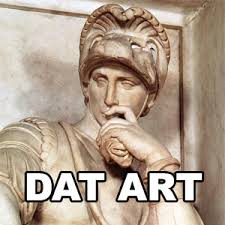Humanism is a system of thought attaching importance to humans rather than divine or supernatural matters. It stresses the potential value and goodness of human beings, emphasizing common human needs. Art of Greece and Rome. This is depicted in the behavior and personality of the Greek gods. The Greek gods, felt jealousy, anger, happiness, among other human emotions. This is different from many modern day religions in which the highest figure must be one dripped in perfection, non-human like in many ways. It allowed for believers to better resonate with the gods.
The art of Greece and Rome were more realistic and a better representation of an actual human. They made their works of art to show human rawness by incorporating facial expressions, body movement (or body in motion), and fine detail. Kroisos from Anavysos which was simply a human statue of a man. However, the detail included in the sculpture employs the elements of humanism. There was less focus on any divine or religious connection, and more emphasis on human features. Body parts such as fingers, toes, and muscles, as well as posture and expression all showed that this was an actual person who was most likely modeling for the artist. Nonetheless, humanism in this sculpture shows the difference in societal ideals the Greeks and Roman’s had in comparison to the Egyptians and Mesopotamians.
In comparison, Mesopotamian or Egyptian views art nude depictions of individuals as a taboo. Being nude was frowned upon and often used as a form of embarrassment. The ancient Egyptian statues often lacked movement, stood straight, and featured animal figures, usually the head, on the human body. Being part animal demonstrated that they were seen as divine and as superior to humans. An example of this would be Anubis, which has the head of a jackal and the body of a man and is the god of the dead. Anubis was the god of embalming and the dead. Since jackals were often seen in cemeteries, the ancient Egyptians believed that Anubis watched over the dead






